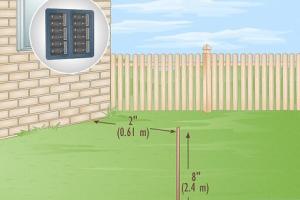The Comprehensive Guide to Ground Rod Installation for Electrical Safety

-
Quick Links:
- 1. Introduction
- 2. Importance of Ground Rod Installation
- 3. Types of Ground Rods
- 4. Necessary Materials and Tools
- 5. Step-by-Step Guide to Installing a Ground Rod
- 6. Expert Tips and Best Practices
- 7. Real-World Case Studies
- 8. FAQs
1. Introduction
Grounding systems are an essential aspect of electrical safety in residential and commercial buildings. Proper ground rod installation mitigates the risk of electrical shock, equipment malfunction, and potential fire hazards. This guide aims to provide a comprehensive overview of ground rod installation, ensuring you have all the necessary knowledge to perform this critical task safely and effectively.2. Importance of Ground Rod Installation
Grounding rods are crucial for several reasons:- Safety: Proper grounding helps protect individuals from electrical shocks and reduces the risk of electrocution.
- Equipment Protection: Grounding protects electrical devices from power surges and lightning strikes.
- Compliance: Many local building codes require grounding systems for new constructions and renovations.
- Performance: A well-installed grounding system improves the overall performance of electrical systems.
3. Types of Ground Rods
There are several types of ground rods available, each suitable for different applications:- Copper Ground Rods: Highly conductive and resistant to corrosion.
- Galvanized Steel Ground Rods: Economical option, though less conductive than copper.
- Stainless Steel Ground Rods: Ideal for environments prone to corrosion.
4. Necessary Materials and Tools
Before starting the installation process, gather the following materials and tools:- Ground rod (copper or galvanized steel)
- Grounding wire
- Ground rod clamp
- Hammer or grounding rod driver
- Shovel (if necessary)
- Multimeter (for testing)
5. Step-by-Step Guide to Installing a Ground Rod
Installing a ground rod requires careful planning and execution. Follow these steps:- Locate the Installation Area: Choose a spot that is easily accessible and away from underground utilities.
- Prepare the Ground: Clear any debris and mark the location for the ground rod.
- Drive the Ground Rod: Use a hammer or grounding rod driver to drive the rod into the ground. The rod should be at least 8 feet deep.
- Connect the Grounding Wire: Attach the grounding wire to the ground rod using a ground rod clamp.
- Test the Grounding System: Use a multimeter to ensure proper grounding.
6. Expert Tips and Best Practices
- Ensure you check local building codes and regulations before installation. - Use a multimeter to test the resistance of the grounding system; it should ideally be below 25 ohms. - If your soil is rocky or hard, consider using a grounding rod driver for easier installation.7. Real-World Case Studies
To illustrate the importance of proper ground rod installation, let's analyze a few case studies: - **Case Study 1:** A commercial building suffered equipment damage due to power surges. After installing a proper grounding system, surge incidents were reduced by 90%. - **Case Study 2:** A homeowner reported multiple electrical shocks in their garage. Following the installation of a grounding rod, the shocks ceased, enhancing safety for the family.8. FAQs
1. What is the purpose of a ground rod?
A ground rod is used to establish a connection between the electrical system and the earth, providing a safe path for electrical surges.
2. How deep should a ground rod be installed?
Typically, a ground rod should be at least 8 feet deep, but local codes may vary, so always check regulations in your area.
3. Can I install a ground rod myself?
Yes, with the right tools and knowledge, a ground rod can be installed as a DIY project. However, consulting a professional is advisable for safety.
4. What materials are ground rods made from?
Ground rods are commonly made from copper or galvanized steel, each offering different levels of conductivity and corrosion resistance.
5. How do I test if my ground rod is working?
You can use a multimeter to test the resistance of your grounding system; it should ideally be below 25 ohms.
6. What is the difference between a ground rod and a grounding plate?
A ground rod is a vertical installation, while a grounding plate is a flat conductor buried in the earth.
7. Is it necessary to have multiple ground rods?
In some cases, multiple ground rods may be necessary to achieve the required grounding resistance.
8. What should I do if my ground rod is not functioning?
If your ground rod is not functioning, check for loose connections, corrosion, or damage, and consider consulting a professional electrician.
9. How can weather affect my ground rod?
Moisture levels in the soil can impact the effectiveness of a ground rod. Dry conditions can increase resistance, while wet conditions improve conductivity.
10. Are there any special requirements for ground rods in my area?
Local building codes may have specific requirements for ground rods, including installation depth and materials. Always check with local authorities.
Random Reads
- How to use google earth
- How to change mac address on android
- How to make a minecraft elevator
- How to flush water heater
- How to flush a british toilet
- How to connect two computers with ethernet cable
- Reorganize samsung apps
- Renewed vs refurbished products
- How to fix a squeaking bed frame
- How to play mobile legends bang bang